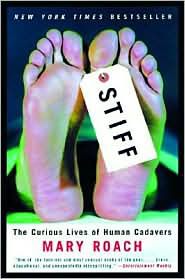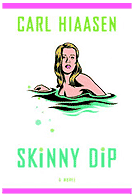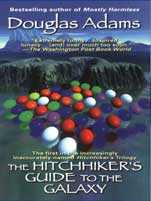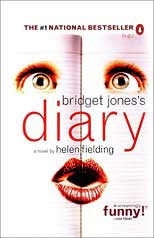

Macabre. Gross. Funny, in a twisted, fascinating way. What does happen to our bodies once we are dead and gone? Ashes to ashes and dust to dust, eventually and in most cases, unless you’ve donated your body to science and then the process is either sped up, as it is dipped in a tub of lye, or delayed indefinitely through plastination. In Stiff: The Curious Lives of Human Cadavers, author Mary Roach takes us on a wild romp through history and science, describing in unsettling detail how cadavers have been used, and are used, in medical research. Although the book is weirdly entertaining, given the subject matter, Roach is always respectful of the bodies, and the people who have donated them.
author Mary Roach takes us on a wild romp through history and science, describing in unsettling detail how cadavers have been used, and are used, in medical research. Although the book is weirdly entertaining, given the subject matter, Roach is always respectful of the bodies, and the people who have donated them.
“The human head is of the same approximate size and weight as a roaster chicken. I have never before had occasion to make the comparison, for never before today have I seen a head in a roasting pan. But here are forty of them, one per pan, resting face-up on what looks to be a small pet-food bowl. The heads are for plastic surgeons, two per head, to practice on. I’m observing a facial anatomy and face-lift refresher course, sponsored by a southern university medical center and led by a half-dozen of America’s most sought-after-face-lifters. The heads have been put in roasting pans – which are of the disposable aluminum variety – for the same reason that chickens are put in roasting pans: to catch the drippings. Surgery, even surgery upon the dead, is a tidy, orderly affair.”
In the chapter entitled “Crimes of Anatomy”, Roach takes us back before the time where there was a legal process in place to donate one’s body to science. In the early 1800s teachers of anatomy had to resort to other means of acquiring bodies on which to practice. Body snatching from recently dug graves was the more usual method, and there was a vigorous trade in the practice. The problem was that nobody wanted to be dissected. The common view of life after death was of the whole body making its way to heaven. Dissection was something only done to the bodies of executed mass murderers.
Continue reading →

If you like rolicking, picaresque novels, you will love Handling Sin. Written in the ’80s(?), it remains one of my favorites.
A mild mannered insurance agent is sedately approaching middle age, living out his comfortable life in a small No. Carolina town. He receives news that his vagabond father has passed away, but to receive his inheritance he has to track down his father’s trumpet, last seen in the possession of a young, attractive black woman who may or may not have been his father’s mistress.
The hero rounds up his S. Panza-like sidekick and off they go on a madcap quest across the South. After many hilarious adventures they also absorb a few life lessons. Can’t really describe many details without giving away a few surprises. So give it a try.

What a howler. Reminiscent of Mickey Spillane, Carl Hiassen’s Skinny Dip starts with crooked sleeze-ball Charles Perrone throwing his wife off a cruise ship miles away from the coast of Florida. Unbeknownst to Chaz, his wife Joey, was a champion swimmer and athlete in college, and turning her fall into a dive, survives the fall, swims to near exhaustion, eventually latches on to a floating bale of marijuana, and is picked up out of the ocean by a retired cop Mick Stranahan. Joey doesn’t understand why Chaz tried to kill her and spends the bulk of this hilarious story with Stranahan figuring out why and taking revenge by driving her husband crazy. The book is filled with great character sketches – Tool, a pain-killer addicted hired thug who gets reformed by the terminally ill old lady whose meds he tried to steal, Red Hammernut, the agribusiness tycoon who is paying off Chaz to falsify water quality records so he can keep his polluting enterprise up and running, and Karl Rolvaag, the homicide detective who keeps two albino pythons and when they escape is disturbed when the yappy dogs of neighbors go missing.
Continue reading →

Seven or eight years ago I had the privilege of hosting Douglas Adams at my home in San Francisco for a brainstorming meeting on a game project (which eventually became Starship Titanic). I had heard of The Hitchhiker’s Guide to the Galaxy, aka H2G2, but hadn’t read it. What I had heard was that it was very funny – Monty Pythonesque humor applied to sci fi. Wanting to get a rise out of Douglas, I made him some tea and served it in a ceramic mug from Japan with a little ceramic frog hiding in the bottom of the cup. Douglas sipped his tea coolly, and when the frog emerged from the depths of the tea Douglas gave a little startled grunt, caught my eye and laughed, and continued to drink his tea. As I expected, unflappable.
Now years later, and three years after Douglas’ untimely passing, I am finally enjoying what brought Douglas his initial fame. The Hitchhiker’s Guide to the Galaxy is the first book in a five book trilogy in which our unsuspecting hero Arthur Dent narrowly escapes the Earth seconds before it is demolished to make way for an interstellar highway. Arthur escapes with his colleague Ford Prefect, who reveals to Arthur that he is actually from another planet and was working on a guidebook to the galaxy before getting stranded on Earth. Catching a lift with the cooking crew of the Vogon ship that destroyed Earth, Arthur and Ford are subjected to the torture of Vogon poetry before being ejected into space, only to be picked up by Zaphod Beeblebrox, the galaxy’s BMOC, with his Heart of Gold improbability spaceship.
Continue reading →

Helen Fielding’s Bridget Jones books are the best antidote I can think of for the grumpies, in my case most recently induced by an unexpected 5 hour layover at SFO. Fortunately most airports these days carry small but decent book stores and even more fortunately in this particular instance the SFO bookstore carried Bridget Jones.
Cervante-esque in their humour, Bridget Jones’s Diary and its sequel Bridget Jones: The Edge of Reason, carry us on a delightful romp through the life and loves of Bridget Jones, a thirty something London girl who can’t quite seem to get anything right, but for whom life magically all works out in the end. The first book is loosely themed around Jane Austin’s Pride and Prejudice, with the male love interest, who Bridget at first spurns, is a one Mark Darcy, a deliciously modern day character equivalent of the first Darcy.
When the Bridget Jones Diary first came out I was bemused to read some reviews, by men naturally, who were appalled by Bridget’s shallow self-obsessions with weight, cigarrettes, drinking, and “shagging”. Well my friends, believe it or not, Bridget’s diary does indeed express the way that most of us single women think and feel. Which is exactly why it is so hilarious. Bridget is exposing our innermost insecurities and obsessions for the whole world to read.
Continue reading →
author Mary Roach takes us on a wild romp through history and science, describing in unsettling detail how cadavers have been used, and are used, in medical research. Although the book is weirdly entertaining, given the subject matter, Roach is always respectful of the bodies, and the people who have donated them.




